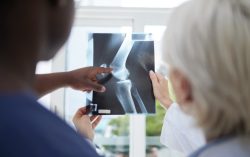Aging Reversed / ABC News
Now researchers have found a way not just to stop, but, reverse the aging process. The key is something called a telomere. We all have them. They are the tips or caps of your chromosomes. They are long and stable in young adults, but, as we age they become shorter, damaged and frayed. When they stop working we start aging and experience things like hearing and memory loss.
In a recent study published in the peer reviewed journal Nature scientists took mice that were prematurely aged to the equivalent of 80-year-old humans, added an enzyme and essentially turned their telomeres back on. After the treatment they were the physiological equivalent of young adults. You can see the before and after pictures in the videos above. Brain function improved, their fertility was restored it was a remarkable reversal of the aging process. In the top video the untreated mouse shows bad skin, gray hair and it is balding. The mouse with it’s telomeres switched back on has a dark coat color, the hair is restored and the coat has a nice healthy sheen to it. Even more dramatic is the change in brain size. Before treatment the aged mice had 75% of a normal size brain like a patient with severe Alzheimers. After the telomeres were reactivated the brain returned to normal size. As for humans while it is just one factor scientists say the longer the telomeres the better the chances for a more graceful aging.
The formal study Telomere dysfunction induces metabolic and mitochondrial compromise was published in Nature.
Additional information published by Harvard can be found in the following articles.
Scientists Find Root Molecular Cause of Declining Health in the Old
Decoding Immortality – Smithsonian Channel Video about the Discovery of Telomerase
While scientists are not yet able to accomplish the same results in humans we believe we have developed a nutraceutical to help prolong youth and possibly extend life until age reversal therapy for humans becomes available.



 PFAS, or “forever chemicals,” are widespread in the environment and can accumulate in our bodies. These synthetic chemicals infiltrate our food, water, household products, and even our bodies. They resist breakdown and persist in the environment and the human body, earning the label “forever chemicals”. Specific strains of human gut bacteria can effectively absorb these “forever chemicals”, trapping them within their cells. The full impact of PFAS on health remains unclear, but studies have connected these chemicals to cancer, heart disease, reduced fertility, and other adverse effects.
PFAS, or “forever chemicals,” are widespread in the environment and can accumulate in our bodies. These synthetic chemicals infiltrate our food, water, household products, and even our bodies. They resist breakdown and persist in the environment and the human body, earning the label “forever chemicals”. Specific strains of human gut bacteria can effectively absorb these “forever chemicals”, trapping them within their cells. The full impact of PFAS on health remains unclear, but studies have connected these chemicals to cancer, heart disease, reduced fertility, and other adverse effects. If you frequently feel the need to nap during the day, you’re not alone. Many people turn to a quick power nap to recharge and combat tiredness. The quality and duration of sleep are closely tied to both physical and mental well-being. Adults should strive for 7-9 hours of sleep per night, which can become increasingly difficult with age. A new study suggests a link between daytime napping and increased mortality risk factors in older adults and seniors.
If you frequently feel the need to nap during the day, you’re not alone. Many people turn to a quick power nap to recharge and combat tiredness. The quality and duration of sleep are closely tied to both physical and mental well-being. Adults should strive for 7-9 hours of sleep per night, which can become increasingly difficult with age. A new study suggests a link between daytime napping and increased mortality risk factors in older adults and seniors. A recent study reveals that residing in regions with heavy pesticide use may substantially elevate cancer risk, comparable to smoking’s impact. The findings highlight that the cumulative effect of multiple pesticides, rather than one specific chemical, is likely the main driver of heightened cancer risk.
A recent study reveals that residing in regions with heavy pesticide use may substantially elevate cancer risk, comparable to smoking’s impact. The findings highlight that the cumulative effect of multiple pesticides, rather than one specific chemical, is likely the main driver of heightened cancer risk. A new brain imaging study indicates that ultra-processed food consumption increases hunger and overeating resulting in weight gain. This is concerning and sparks worries that these widespread products may fundamentally reshape our eating patterns. This may be a result of altered brain structure by changing neural pathways.
A new brain imaging study indicates that ultra-processed food consumption increases hunger and overeating resulting in weight gain. This is concerning and sparks worries that these widespread products may fundamentally reshape our eating patterns. This may be a result of altered brain structure by changing neural pathways. A recent study suggests that phosphate additives, commonly used to preserve and enhance the flavor of processed packaged foods, may increase blood pressure. This is due to causing the protein FGF23 to build up in the blood and infiltrate key brain areas, such as the brain stem, that regulate blood pressure.
A recent study suggests that phosphate additives, commonly used to preserve and enhance the flavor of processed packaged foods, may increase blood pressure. This is due to causing the protein FGF23 to build up in the blood and infiltrate key brain areas, such as the brain stem, that regulate blood pressure. A well-balanced gut microbiome is essential for supporting overall health, including the absorption of essential bone-building nutrients. When gut health declines, the body’s ability to absorb these nutrients is compromised. Studies have connected a healthy gut microbiome to improved bone density.
A well-balanced gut microbiome is essential for supporting overall health, including the absorption of essential bone-building nutrients. When gut health declines, the body’s ability to absorb these nutrients is compromised. Studies have connected a healthy gut microbiome to improved bone density. Swimming is an excellent form of exercise, but the chemicals used to keep pools germ-free can pose health to various parts of the body. A recent study highlights that disinfectants commonly used in swimming pools, such as chlorine and bromine, produce disinfection by-products when they interact with organic materials in the water. These by-products, called chloramines, form when chlorine reacts with substances like sweat and urine. Chloramines can irritate the eyes, skin, and respiratory passages, posing health risks to swimmers.
Swimming is an excellent form of exercise, but the chemicals used to keep pools germ-free can pose health to various parts of the body. A recent study highlights that disinfectants commonly used in swimming pools, such as chlorine and bromine, produce disinfection by-products when they interact with organic materials in the water. These by-products, called chloramines, form when chlorine reacts with substances like sweat and urine. Chloramines can irritate the eyes, skin, and respiratory passages, posing health risks to swimmers. Recent research indicates that smoking marijuana or consuming THC gummies can adversely affect vascular health. Even healthy individuals who use cannabis may have a higher risk of developing heart disease.
Recent research indicates that smoking marijuana or consuming THC gummies can adversely affect vascular health. Even healthy individuals who use cannabis may have a higher risk of developing heart disease.